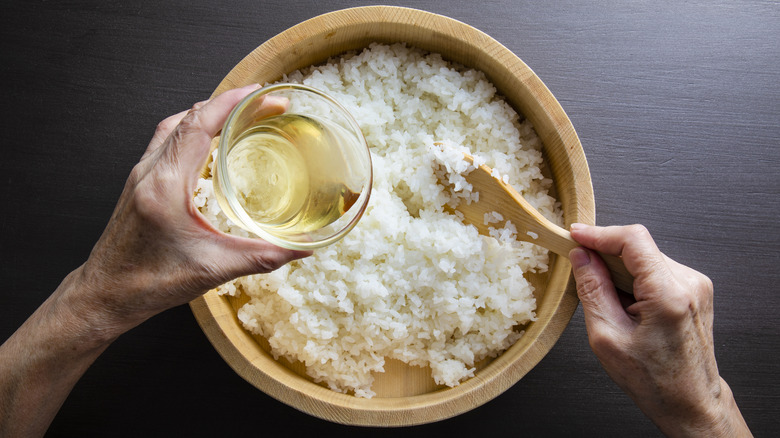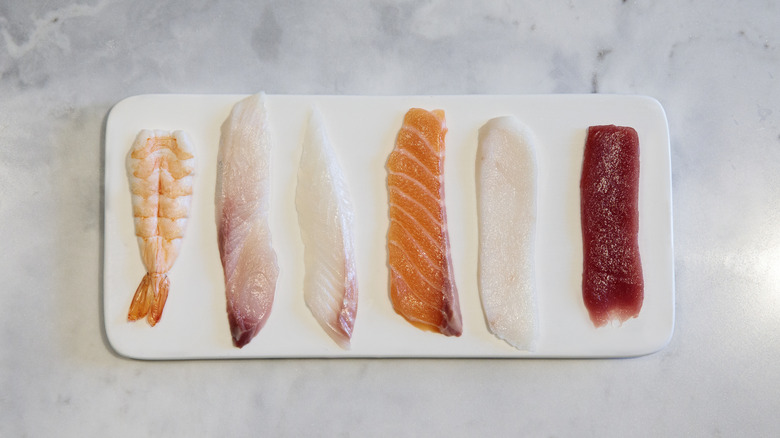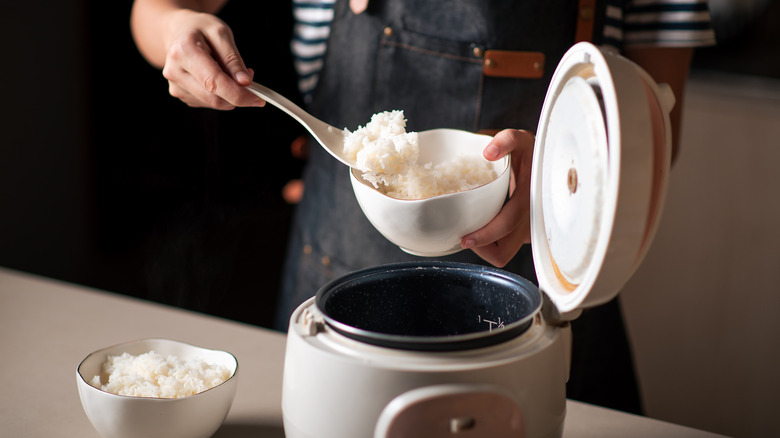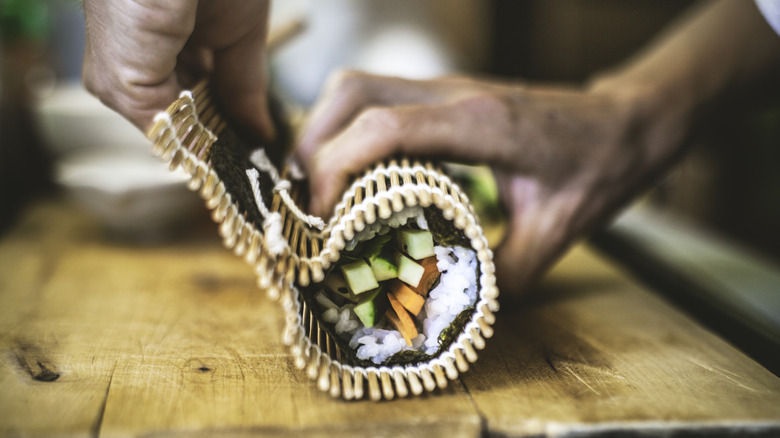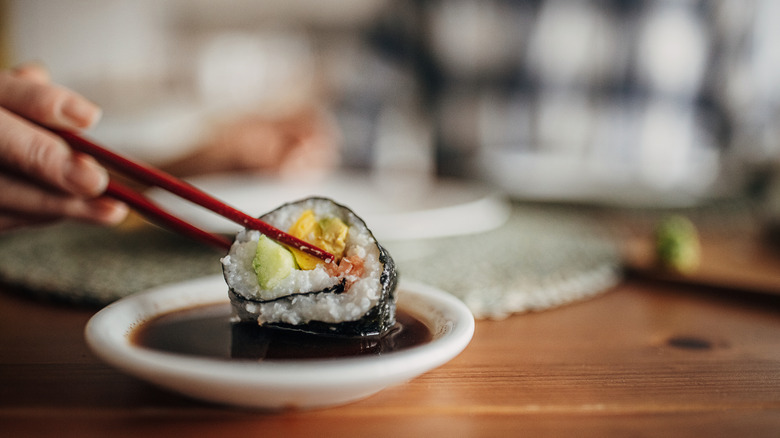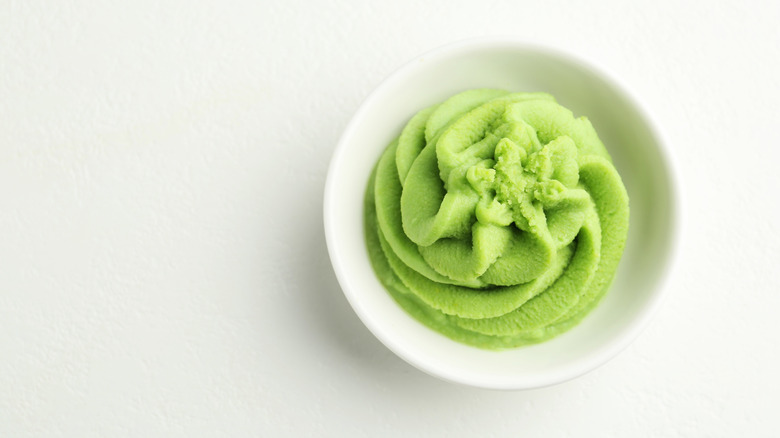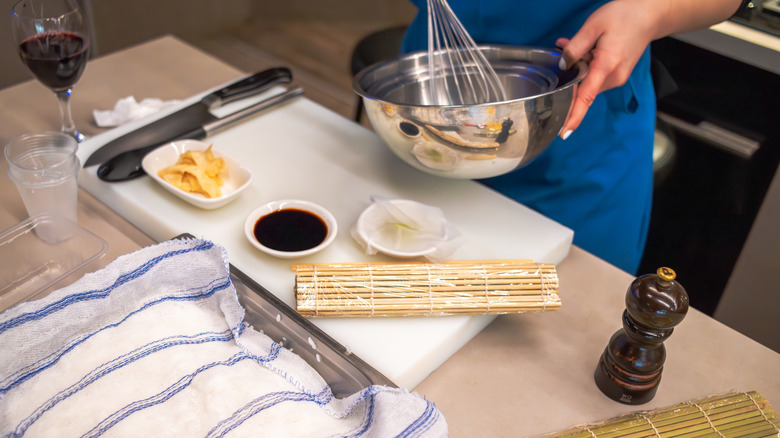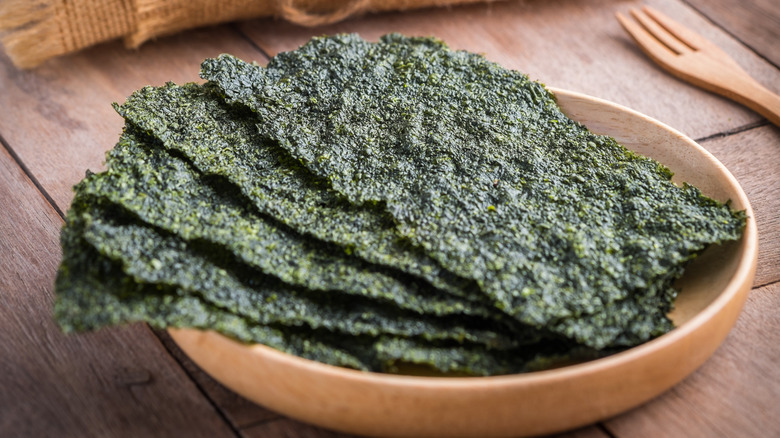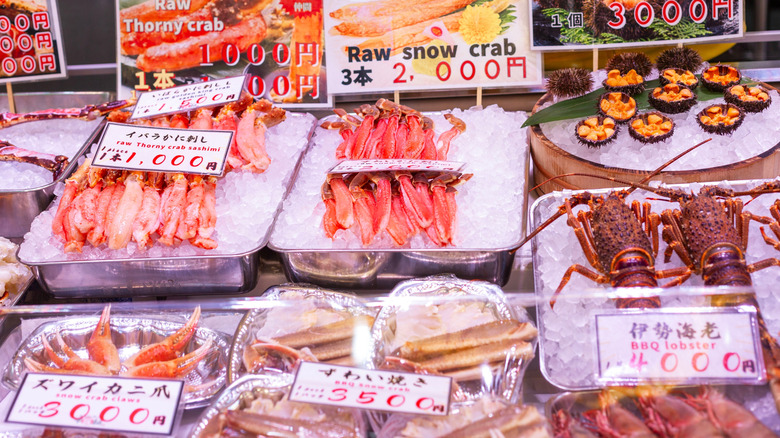12 Common Mistakes That Will Ruin Your Homemade Sushi
If you can grow your own sourdough starter or cook this delicious Beef Wellington Recipe, why wouldn't you be able to make sushi at home? While it might sound intimidating, it can be a fun and exciting cooking experience if you're looking to try something new. Whether you want to try your cards at making sushi rolls, nigiri, temaki, or simply just sashimi, it's a great way to expand your knowledge of sushi making and Japanese cuisine.
Growing up in a Japanese-American household, it was essential for every family gathering to have a big plate of homemade sushi on the dinner table. My grandmother would spend the afternoon in the kitchen prepping all the ingredients, from steaming the rice and slicing the otoro and unagi, to toasting the nori. These skills then translated over to my formal experience working at a Japanese eatery in Southern California. In the kitchen, we regularly butchered large bluefin tuna and yellowtails to create menu items such as sashimi, nigiri, and temaki.
Something that has always stuck with me — whether it was in my family home or at work — was if you had the freshest quality sushi-grade fish, seasoned sushi rice, and a sharp knife, you're on pace for creating delicious sushi. After watching my grandmother prepare endless plates of sushi over the years and working at a Japanese restaurant making homestyle sushi, these are the few mistakes that might ruin your homemade sushi.
Using the wrong type of rice
One of the biggest mistakes you can make when making sushi is using anything other than short-grain Japanese rice. Whether it's jasmine, arborio, or basmati, you're not making sushi unless you use short-grain Japanese rice.
If you've ever felt sushi rice, you know it's almost like glue. You may ask, what makes sushi rice so sticky? This type of rice is naturally sticky due to the high content of a starch called amylopectin, which contributes to the homogeneous consistency necessary for keeping your sushi rolls and nigiri tight and secure. The starch enables the grains to stick together, creating the ideal texture for sushi. Once slightly cooled, the rice can be molded into practically any shape. It's also used to make Japanese rice balls called onigiri, which are usually filled with vegetables or protein like shredded tuna and mayo.
In stores, it's labeled as "sushi rice" and is typically found at your local supermarket, but Asian supermarkets will definitely have it in stock. Bonus points if you can find a Japanese brand, too! Once you pick up a bag of Japanese short-grain rice, you're on the right track to making the best homemade sushi around.
Not properly seasoning your rice
Besides the sticky consistency of sushi rice, have you ever wondered why it has a slightly sweet and tangy taste? Well, that's because it's seasoned to perfection. Sushi rice is typically seasoned with the same ingredients: rice vinegar, granulated white sugar, and sea salt. These ingredients create the delicious acidic and sweet flavor that's so notable from sushi rice.
Each ingredient plays a vital role in creating the scrumptious flavor. Rice vinegar provides the signature sourness, and to balance the acidity, it is softened by sugar. The sea salt, of course, enhances the overall flavor, but it also contributes to the stickiness of the rice. This mixture should be heated in the microwave for around 30 seconds to ensure the sugar and salt dissolve completely. After it's dissolved, the mixture is ready to be folded into your rice. Traditionally, the seasoning is folded by using a shamoji (a traditional wooden rice paddle), however, you can just use a heat-proof rubber spatula. The folding technique ensures each grain of rice is coated in the seasoning without crushing the rice, preserving its texture.
You can use sushi rice as the foundation for your sushi nights at home, or if you want a more leisurely dinner, serve it with sliced fish or meat alongside vegetables, pickled ginger, and soy sauce for a poke bowl or donburi.
Using poor-quality fish
One of the first things you should think of when making sushi at home is where you're going to buy your sushi-grade fish. You might be wondering, what even is sushi-grade fish? To put it plainly, sushi grade, sometimes referred to as "sashimi-grade" is a term used to indicate that the fish is high-quality and safe for raw consumption. It's an unregulated term judged by the seller of the fish to indicate the freshness and quality of the fish that's intended for sushi-making or sashimi.
It's crucial to use sushi-grade fish whenever you're making sushi to ensure your fish isn't contaminated with parasites and other bacteria that might cause a foodborne illness. Depending on the species of the fish, the FDA recommends the fish be frozen for specific periods of time and temperature to get rid of any parasites.
At the end of the day, there are a few things you should always look out for when buying sushi-grade fish. First, make sure you're buying from a reliable fishmonger or vendor that has a high turnover rate with their products. Secondly, you should smell the fish to make sure it doesn't have a fishy aroma and it just simply smells like the ocean. Next, the fish shouldn't have any sort of discoloration. It should always be shiny, vibrant, and brightly colored. Additionally, the flesh should always be tight, tender, and firm — any fish that has gray, dark coloration, and soft flesh should be discarded.
Improperly cooking your rice
The journey to delicious homemade sushi begins with the right preparation of sushi rice. Besides the fish, it's the main ingredient in the sushi, and you want to make sure you cook it properly to obtain the best sushi possible.
You want to start by rinsing it under cold water to remove any excess starch before cooking. This will prevent the rice from becoming too gummy. Once it's rinsed, let your rice soak in cold water for around 30 minutes to allow the grains to absorb the water. After soaking, pour out the water and measure the rice-to-water ratio. Depending on your cooking method, the gold standard is a 1:1 ratio, accounting that you've soaked your rice beforehand. If you didn't soak your rice beforehand, no big deal, just use a 1:1.5 ratio, rice being 1 cup and water being 1 1/2 cups. Before cooking, some sushi chefs often add a piece of kombu (a type of edible seaweed) to enhance the umami flavor of the rice.
You can cook the rice in a rice steamer or the stovetop, using a stainless steel pot or the traditional Japanese clay pot called "donabe." It's one of the most beloved cookware vessels throughout Japan and has been used to cook rice, soups, and even steaming fish and vegetables. Whichever cooking vessel you choose, be sure to let the rice rest with the lid on for 10 minutes after cooking to ensure each grain is tender.
Overfilling the rolls
One of the most daunting parts of making sushi is the rolling process. The fear of your ingredients bursting through the nori or breaking apart when being cut is constantly looming over you. To make sure you're not overfilling, it's all about using the right method and tools.
To get the perfect structure, pick up a bamboo mat called "makisu," and it'll make rolling the sushi a breeze. Once your ingredients are ready, place your nori on the makisu and lay a thin layer of rice on the nori, leaving about ½ inch on the top edge. It's crucial to smear a few pieces of rice on the top to act as a glue, ensuring your roll will hold together. Then, add your filling in the center and roll up the sushi using the mat, tucking the filling inwards as you go. Once it's rolled, seal the nori and give it a gentle squeeze to firm the roll up a bit. Make sure to use a sharp knife whenever you're slicing the sushi roll so you can get the perfect cut.
You can also make sushi that doesn't require any rolling. If you're apprehensive about your sushi rolling skills, try making temaki, or hand rolls, instead. All you have to do is slice your nori in half, add your rice and desired fish, and then fold the nori over your fillings and enjoy!
Using too much soy sauce
It's almost like second nature when you go to sit down at a sushi restaurant to pour yourself a side dish of soy sauce. However, just because there is soy sauce on the table doesn't mean you need to dunk every bite of sushi in it. Soy sauce should be used sparingly and thoughtfully. The primary goal is to enhance the flavor of the fish, not the rice.
In most sushi bars in Japan, soy sauce is added on by the sushi chef depending on the type of fish you're eating. Traditionally, the chef will lightly brush the fish in sweet soy sauce called "nikiri," which is made by boiling soy sauce, mirin, sake, and dashi broth until it's concentrated. By using this method it ensures the precise amount of sauce is being consumed and avoids over-saturating the rice with soy sauce. If you're making sushi at home, try making a nikiri sauce from scratch and avoid submerging your sushi in a pool of soy sauce so you can taste the quality of your fish.
Not having an organized workspace
Just like anything you're cooking in the kitchen, sushi-making requires a clean and organized workspace. If you are trying to get in the flow of being the best possible home cook out there, you should be familiar with the French term, "mise en place," which translates to "put in place." This term refers to the preparation and organization of ingredients and equipment before the cooking process begins — and this is exactly the rule of thumb you should follow when making sushi at home.
Since sushi-making requires minimal cooking, it's fairly easy to prepare all of your ingredients before you start rolling, like making your sushi rice, cleaning and cutting your vegetables, and preparing your fish. It's easy for your workspace to become chaotic with vegetable trimmings and dirty cutting boards everywhere, but as long as you're keeping your station clean and preparing your ingredients in advance, you should be on track for a successful sushi night at home.
One way to keep your kitchen workspace tidy is by using sheet pans to organize your mise en place. Just arrange all of your prepared ingredients in various bowls on the sheet pan and get to rolling your sushi! You can also have another tray with the tools you might need so you don't have to be scrambling around the kitchen trying to find your tools.
Not using wasabi properly
Similar to soy sauce, using wasabi improperly can easily ruin the taste of your homemade sushi. While it might be common in the United States to smear loads of wasabi on your sushi or dissolve wasabi in your soy sauce, in Japan, this is often discouraged. Traditionally, the sushi chef will add wasabi depending on the type of sushi and sashimi being served. Typically, the sushi chef will directly apply it to the sashimi or place it in between the rice and fish in the nigiri, giving it a subtle flavor boost.
Majority of the time, the wasabi you're eating at sushi restaurants and bars is actually fake. Since the wasabi plant is difficult and expensive to grow in the United States, it is often made with a mixture of horseradish, mustard, and green food coloring. At most Japanese supermarkets and specialty stores, you can find fresh wasabi plants for sale. If you don't have one in the area, try ordering one from a vegetable wholesale provider or reliable farm online.
If you happen to find a real wasabi root you might as well invest in a "samegawa oroshi," the tool traditionally made for grating wasabi. Just make sure to use the wasabi sparingly so you don't overwhelm the flavor of the fish.
Not utilizing other seasonings
In addition to soy sauce and wasabi, there are plenty of other delicious seasonings in Japanese cuisine that are excellent for sushi-making. When searching for the perfect condiment, you want to make sure it pairs well with the fish and seafood you're planning on showcasing in your sushi rolls. To find the right one, you might want to take a trip to the Asian supermarket.
After selecting your fish, whether it be tuna or sea bass, head to the condiment aisle and start searching around. One staple Japanese condiment that goes well with sushi is yuzu kosho. It has a bright citrusy flavor with a spicy kick from its combination of green chili peppers, yuzu citrus, and salt. If you can't handle the heat of the wasabi, yuzu kosho is a great replacement. While you're there, pick up a bottle of Japanese mayonnaise. This type of mayonnaise has a slightly custardy texture and rich-umami flavor that's great for making spicy sauce or even yuzu mayo. Another item you might want to pick up is a bottle of roasted sesame oil. Roasted sesame oil has a rich nutty and caramelized flavor that's perfect for drizzling over your homemade sushi rolls.
If you are new to sushi-making or even just shopping at Asian supermarkets, be adventurous and look at the different bottles of sauces and seasonings to see what might pair well with your homemade sushi. This is a great way to expand your palate and use different seasonings to elevate your sushi to the next level.
Not having the right kitchen tools
Just like how there are pans every baker should have, there are kitchen tools that every sushi-maker should own. In sushi-making, whether it's made at home or done by a professional behind the sushi bar, it's crucial to have a few tools to simplify the process.
The most important one is a sharp and sturdy knife. It doesn't have to be a fancy sushi knife that costs more than a whole bluefin tuna, it can simply be a basic chef's knife with an 8-inch blade. Alongside a sturdy knife, a high-quality cutting board is also handy. It's key to find one that's not porous, like plastic, marble, or glass, so you won't have any lingering odors attached to your fish. Another item that's great to have is a rice paddle to help you get the mix through the rice without smashing the grain, and, of course, you should also pick up a bamboo sushi mat for an easy rolling process. Also, if you want to elevate the dining experience, pick up some high-quality chopsticks, and it'll surely set the mood for your sushi night at home.
Not using freshly roasted nori
Alongside rice, nori is one of the essential foundations that holds the structure of sushi rolls together. Whenever you're making sushi, it's extremely important to use freshly roasted nori for a sturdy structure and a nice crisp texture. To ensure your nori stays fresh, make sure to keep it in an airtight container in a dry environment.
If you want to give your nori an even more roasted and toasted flavor, you can do it at home! To toast your nori, set your burner over medium-low heat and drag the nori sheet over the burner quickly. Do this about one to two times on each side of the nori and use it after it has cooled. Make sure to not let the nori directly touch the flame and be quick to prevent it from burning. Toasting your nori will give it a richer, more pronounced umami flavor and it'll create a more desirable crunchy texture.
Only using fish for your filling
While the fatty goodness of bluefin tuna belly and the buttery taste of salmon are undeniably delicious, there are numerous other ingredients you can use as sushi fillings besides fish.
A popular choice in Japan, apart from fish, is unagi or freshwater eel. You can find it in Asian supermarkets, often served whole and typically marinated in savory barbecue sauce. The sweetness of sushi rice combined with the savory, buttery flavor of unagi creates an utter flavor explosion. Another option is to use steamed crab, lobster, or shrimp — any crustacean you might have on hand is a good choice. For those who aren't particularly fond of seafood, you can use this Korean BBQ Beef recipe as a filling to make a cooked sushi roll.
Beyond protein, sushi can be filled with a variety of vegetables. Whether you're plant-based or simply want to add more veggies to your meals, incorporating sliced avocado, cucumbers, or radishes into your sushi rolls is always a great idea. In Asian supermarkets, you can find numerous pickled vegetables — like burdock root, kimchi, or danmuji (a pickled Korean radish) – that are perfect for adding extra crunch and acidity to sushi rolls. Another filling idea is to thinly slice some carrots and sauté them in a pan with sesame oil and salt until tender. Pro tip: adding a smear of Japanese mayonnaise will significantly enhance the flavor.


